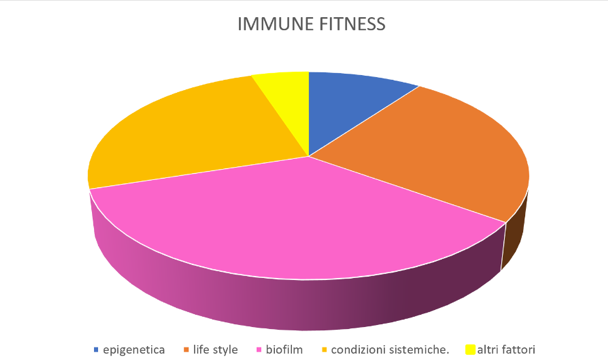Changing the patient - February 20, 2020
“It's not your hand that makes the difference in people’s lives" Filippo Graziani
This sentence underlines the importance of the personalised management of each periodontal patient. We will be good clinicians when we are able to manage, in our dental office, the person, for life. In fact, the periodontology of the future is managing the person and not the disease. The periodontology of the future will not only be able to change the prognosis of the tooth, but it will change the life of the person, it will analyse the risk factors with more precision, it will talk about immune fitness and lifestyles.
We know that Periodontitis has a multifactorial aetiology, and thus our initial assessment should not be confined only to periodontal probing and charting. Lifestyles and systemic diseases can reduce the fitness of our immune system and therefore go towards changing the parameter of inflammation (Table 1). Thus, we should record 12 crucial aspects of our patient together with the periodontal chart, which are:

- Age
- Origin
- Social status
- Occupation
- Smoking
- Stress
- Family history of periodontal disease
- Diet
- BMI
- Sport
- Blood pressure
- Systemic conditions
In particular, I want to focus on one of the risk factors already widely discussed in the scientific literature (Tomasi et al., 2007) that, together with the bacterial plaque, causes a higher risk of periodontal disruption (Fig. 1-2). I’m referring to smoking habits.

Fig. 1 : Probability of "pocket closure" ( probing pocket depth ≤ 4 mm) according to the initial PPD for smokers and non-smokers
From a multilevel analysis of non-surgical periodontal treatment (Tomasi et al., 2007).
Taking into account this aspect, I want to summarise and underline the most critical aspects of new smoking trends.
ENDS and HNBD are two acronyms that stand for Electronic Nicotine Delivery System and Heat-Not Burned Devices. We will all soon be familiar with these acronyms because more and more scientific research is studying their effects on people’s health.
Are E-Cigarettes completely harmless? Are flavoured liquids safe? What are the effects on the oral cavity? What are the new trends? What are the FDA recommendations?
I think this is an important question that we need to ask ourselves, and that opens up a lot of discussion and reasoning. While electronic cigarettes may appear in some cases to be a good way of gradually reducing nicotine levels, they also have negative aspects that have to be taken into account.
The New England Journal of Medicine has stated that e-cigarettes are good tools to reduce and quit traditional cigarette smoking when compared to nicotine replacement therapy (Hajek et al., 2019). The two main positive aspects highlighted in the research are that the rituality is not lost, and the percentage of nicotine can be gradually reduced. However, it's habitual actions that together with the rituality can make you fall back into vice. In fact, in another article (Caponnetto et al., 2013) e-cigarettes are recommended only to patients that show no intention of quitting smoking. The most important side effect can be a reversal of the trend: from e-cigarette smoking to traditional smoking: the age group most affected are teenagers. Thanks to their appealing aromas and modern design, ENDS devices are smoked by teenagers, eventually leading them to start using traditional cigarettes. Electronic cigarettes attract young people and they are also sold online, making e-cigarettes accessible to everyone with no restriction of age.
Soon, the flavours of e-cigarettes will be banned, and only mint flavours will be retained (Drazen et al., 2019). The chemical liquids with buttery and caramelised flavours, due to the presence of harmful chemical compounds, seem to decrease the functionality of the ciliated epithelial cells present in the respiratory tract of our body.
The most famous HNBD is Philip Morris’ IQOS. Philip Morris intends to have IQOS approved as MRTP (Modified Risk Tobacco Products) by the FDA. It’s an ambitious project because MRTP is tobacco products that are sold or distributed for use to reduce harm or the risk of tobacco-related disease associated with commercially marketed tobacco products.
HNBD seems to be less damaging when compared to ENDS and TS (Traditional Smoking) (Biondi-Zoccai et al., 2019), while ENDS seems to be better than traditional cigarettes.
The principle behind this statement is that there is no combustion of tobacco in the electronic cigarette, but there is nicotine. In IQOS there is no combustion of tobacco, and the stick is heated to 350 degrees, unlike the combustion in regular cigarettes (900 degrees). However, there are still no long-term studies to evaluate the carcinogenesis of these new devices.
E-cigarettes remain controversial because the scientific evidence of short term and long term effects on tolerance and the health value of a switch from tobacco to e-cigarettes is contested and controversial (Sultan et al., 2018).
What we can do as health professionals?
We have to use the pie chart (Table 1) to evaluate the contributing factors that reduce the immune fitness of our patients and raise awareness in them. We must support behaviour change: the first step toward it is developing empathy (Ramseier and Suvan, 2010) using open questions, affirmations and reflective listening to engage with and get to know the patient better.
We should get familiar with the Anti-smoking centres in the vicinity of our workplace to motivate the patient better and make them aware of other specialists that can help them.
In Italy, 20% of people smoke, and they must be informed of the dangerous side effects of smoking on their systemic and oral health. It’s our imperative, as health professionals, to raise awareness in people and keep up to date on new trends on smoking. This is WHY for me, preventive medicine and preventive dentistry is fundamental.
It’s not only about teeth, it’s about people's lives.
Literature and suggested reads:
Biondi-ZoccaI et al. (2019.) Acute Effects of Heat-Not-Burn, Electronic Vaping, and Traditional Tobacco Combustion Cigarettes: The Sapienza University of Rome-Vascular Assessment of Proatherosclerotic Effects of Smoking ( SUR - VAPES ) 2 Randomized Trial. Journal of the American Heart Association, 8, e010455. https://www.ncbi.nlm.nih.gov/pubmed/30879375
Caponnetto, P., Campagna, D., Cibella, F., Morjaria, J.B., Caruso, M., Russo, C., Polosa, R. (2013). EffiCiency and Safety of an eLectronic cigAreTte (ECLAT) as tobacco cigarettes substitute: a prospective 12-month randomized control design study. PLoS ONE 8, e66317. https://www.ncbi.nlm.nih.gov/pubmed/23826093
Drazen, J.M., Morrissey, S., Campion, E.W. (2019). The Dangerous Flavors of E-Cigarettes. New England Journal of Medicine, 380, 679–680. https://www.ncbi.nlm.nih.gov/pubmed/30699053
Hajek, P., et al. (2019). A Randomized Trial of E-Cigarettes versus Nicotine-Replacement Therapy. New England Journal of Medicine, 380, 629–637. https://www.ncbi.nlm.nih.gov/pubmed/30699054
Mazzucchelli, L. (2019). Fattore 1%: Piccole abitudini per grandi risultati. Florence, Italy: Giunti. https://www.giunti.it/catalogo/fattore-1-9788809988569
Ramseier, C. A., & Suvan, J. E. (Eds.). (2010). Health Behavior Change in the Dental Practice. Ames, Iowa USA: Blackwell Publishing, Inc. https://onlinelibrary.wiley.com/doi/book/10.1002/9781118786802
Sultan, A.S., Jessri, M., Farah, C.S. (2018). Electronic nicotine delivery systems: Oral health implications and oral cancer risk. Journal of Oral Pathology and Medicine. https://www.ncbi.nlm.nih.gov/pubmed/30507043
Tomasi, C., Leyland, A.H., Wennström, J.L. (2007). Factors influencing the outcome of non-surgical periodontal treatment: a multilevel approach. Journal of Clinical Periodontology, 34, 682–690. https://www.ncbi.nlm.nih.gov/pubmed/17635246
